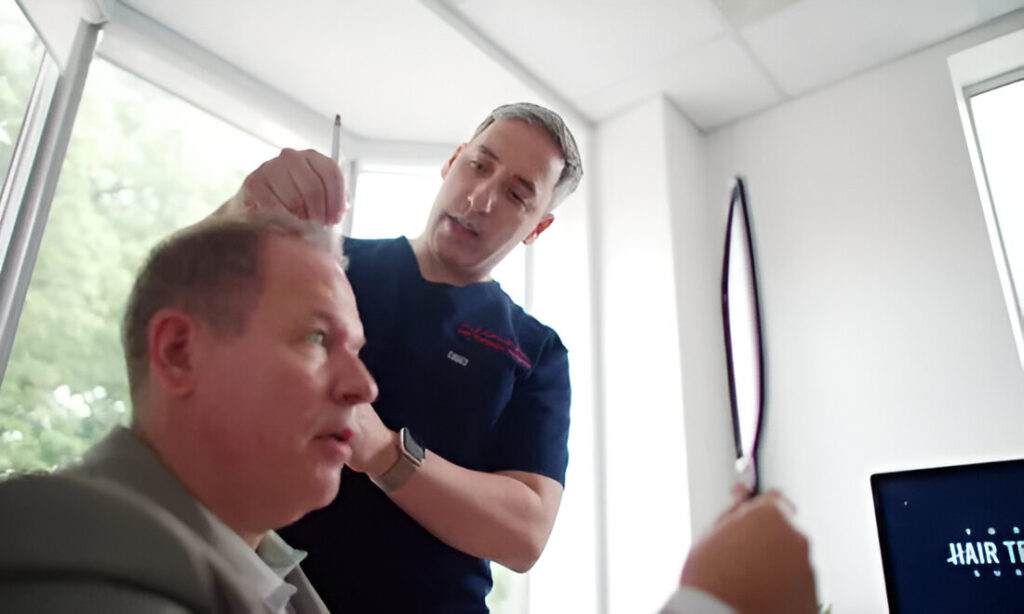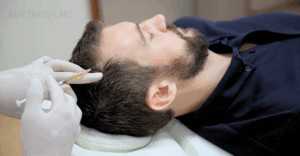Hair loss is a common concern that affects millions of people worldwide. Whether you’re noticing the first signs of thinning or have been dealing with significant hair loss for years, understanding the best treatments for your stage of hair thinning can make a big difference in restoring your confidence and appearance. With various solutions available, ranging from medications like finasteride and minoxidil to more advanced hair restoration options such as PRP or hair transplant surgery, individuals have many effective hair loss treatments to consider.
In this post, we will explore the causes of hair loss and explore hair loss treatments for different stages of thinning, diving into the treatment options for early, moderate, and advanced hair loss. Our goal is to educate and empower you with knowledge and options that best suit your journey toward hair restoration.
Key Takeaways
- Understanding the Cause is Crucial: Hair loss can result from genetics, hormonal imbalances, medical conditions, or lifestyle factors. Identifying the cause is the first step toward planning effective treatment.
- Early Intervention Matters: Treatments like minoxidil, finasteride, and PRP treatments can be highly effective during the early stages of hair thinning.
- Combination Treatments for Moderate Thinning: Combining therapies like PRP, laser treatments, and medications often yields the best results in this stage.
- Advanced Options for Severe Hair Loss: Hair transplant surgery and combination therapy provide solutions for advanced stages of hair loss.
- Preventive Care is Key: Gentle hair care and habits, a nutrient-rich diet, and stress management can help prevent or slow further hair loss.
- Professional Consultation is Essential: A tailored plan developed by hair restoration specialists ensures you choose the right treatments for your unique needs.
- Expertise Makes a Difference: Canada’s leading hair transplant experts offer advanced, personalized solutions to help restore your confidence and achieve natural-looking results.
Table of Contents
- Introduction
- What Causes Hair Loss?
- Stages of Hair Thinning and Best Hair Loss Treatments
- Preventive Measures for Hair Thinning
- Choosing the Right Hair Loss Treatment for You
- Why Trust Canada’s Leading Hair Transplant Clinic?
- Conclusion
What Causes Hair Loss?
Hair loss can occur for various reasons, and understanding the root cause is essential for choosing the most effective hair loss treatments. Some common causes include:
- Genetics (Androgenetic Alopecia): A hereditary condition often referred to as male or female pattern baldness.
- Hormonal Changes: Conditions like pregnancy, menopause, or thyroid imbalances.
- Medical Conditions: Alopecia areata, scalp infections, or certain chronic illnesses.
- Lifestyle Factors: Stress, poor nutrition, or overuse of harsh hair products.
- Medications: Some drugs are used for treating cancer, depression, or high blood pressure.
Stages of Hair Thinning and Best Hair Loss Treatments
1. Early Stages of Hair Thinning
The early stages of hair thinning often manifest as a receding hairline, increased shedding, or slightly less volume. At this stage, addressing the problem promptly can prevent further hair loss.
Effective Treatments for Early Thinning:
- Minoxidil: A topical solution available over the counter that stimulates hair follicles and encourages growth.
- Finasteride: An FDA-approved oral medication for men that blocks DHT (a hormone linked to hair loss).
Scalp Treatments for Hair Loss:
Medicated shampoos with ingredients like ketoconazole can improve scalp health and stimulate growth.
- Stem Cell Banking: New regenerative treatments to recover hair loss are coming quickly, and the cells found in your own follicles are the key ingredient. As we age, so do our cells, and over time, they become more damaged and less capable. Non-invasive stem cell banking with ACORN cryogenically preserves your cells to give you peace of mind about your future.
- Hair Fibres: A temporary (washable) option for those experiencing early hair loss may be the use of cosmetic hair fibres. Typically made from keratin, hair fibres bind with existing hair and boost the fullness of hair. Easily applied, hair fibres like Instant Hair can provide some extra confidence without a large financial outlay.
2. Moderate Hair Thinning
In moderate thinning, the hair appears visibly thinner across the scalp, with noticeable gaps or patches. At this stage, a combination of treatments may be required for effective results.
Best Hair Loss Treatments for Moderate Thinning:
- Platelet-Rich Plasma (PRP) Therapy: A non-surgical treatment where platelet-rich plasma is injected into the scalp to promote growth.
- Laser Hair Therapy: Low-level laser devices stimulate hair follicles and increase blood flow to the scalp.
- Minoxidil: A topical solution available over the counter that stimulates hair follicles and encourages growth.
- Finasteride: An FDA-approved oral medication for men that blocks DHT (a hormone linked to hair loss).
- Minoxidil Caffeine and Finasteride (MCF): This is a combination medication our experts at Toronto Hair Transplant Surgeons will recommend for qualified patients. This formulation uses the best scientific breakthroughs which suggest that caffeine may potentially enhance the effectiveness of both minoxidil and finasteride by stimulating hair follicles and improving blood flow to the scalp.
- Hair Transplant Surgery: Follicular Unit Extraction (FUE) and Follicular Unit Transplantation (FUT) are surgical options where hair follicles are harvested from a donor area and transplanted to thinning areas. At a moderate stage of hair loss – surgery may be specifically targeting a smaller area (ie – widow’s peak or temples from traction alopecia) vs the larger scale surgeries sought for more advanced hair loss. The tricky part about a hair transplant surgery at moderate stages of hair loss is assessing what future hair loss may occur (if hair loss cannot be prevented). For this reason, hair transplant surgeries are not generally the best option for patients under 25 years of age.
3. Advanced Hair Thinning and Balding
Advanced thinning often involves significant hair loss on the crown, temples, or across the entire scalp. While regrowth may be limited, restoration techniques can offer dramatic improvements. Combination therapies are even more critical at this stage of hair loss as it is imperative to also take action to preserve existing hair.
Effective Treatments for Advanced Hair Loss:
Hair Transplant Surgery:
Follicular Unit Extraction (FUE) and Follicular Unit Transplantation (FUT) are surgical options where hair follicles are harvested from a donor area and transplanted to thinning areas.
Combination Therapy:
Using finasteride, minoxidil, PRP and laser therapy individually or together can help to maintain existing hair and improve surgical outcomes. Essentially, take whatever steps you can to preserve existing hair and boost the health of transplanted growth.
Preventive Measures for Hair Thinning
Regardless of the stage, prevention is key to slowing down hair loss. Here are some simple tips to incorporate into your routine:
Gentle Hair Care:
Avoid harsh shampoos and products and excessive use of heat styling tools that weaken your hair.
Healthy Diet:
Consume a balanced diet rich in protein, vitamins, and minerals essential for hair growth. Maintaining your overall health and wellness is just, well, better for your whole body.
Stress Management:
If you do find yourself experiencing high-stress periods, consider practices such as yoga, meditation, or regular exercise that can reduce stress and therefore can help with stress-related hair loss.
Regular Scalp Maintenance:
Keep your scalp healthy to maintain optimal conditions for hair growth. This means everything from the frequency of washing your hair and scalp to avoiding or minimizing tight hairstyles or accessories that create friction (think tight hats or helmets).
Choosing the Right Hair Loss Treatment for You
With so many hair restoration options available, choosing the right treatment depends on the stage of thinning, the cause of your hair loss, and your personal preferences. Consulting with a specialist is the best way to create a customized plan that fits your needs. For some, combining non-surgical hair loss treatments with lifestyle changes can yield excellent results, while others may benefit from surgical interventions.
Why Trust Canada’s Leading Hair Transplant Clinic?
At Toronto Hair Transplant Surgeons, we specialize in personalized hair restoration solutions for every stage of thinning. Our team of expert surgeons use cutting-edge technology and advanced techniques to help you achieve natural-looking results. Whether you’re interested in non-surgical treatments like PRP or considering a hair transplant, we’re here to guide you every step of the way.
Conclusion
Finding the best hair loss treatment requires understanding the underlying causes of hair thinning and acting early. From topical solutions and medications to advanced surgical options, there’s a solution for everyone. If you’re struggling with hair loss and want to explore the most effective hair loss treatments, contact us today to schedule a consultation.






